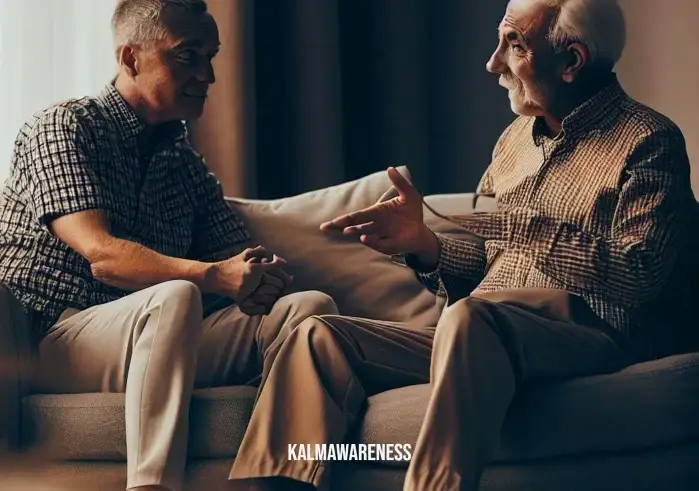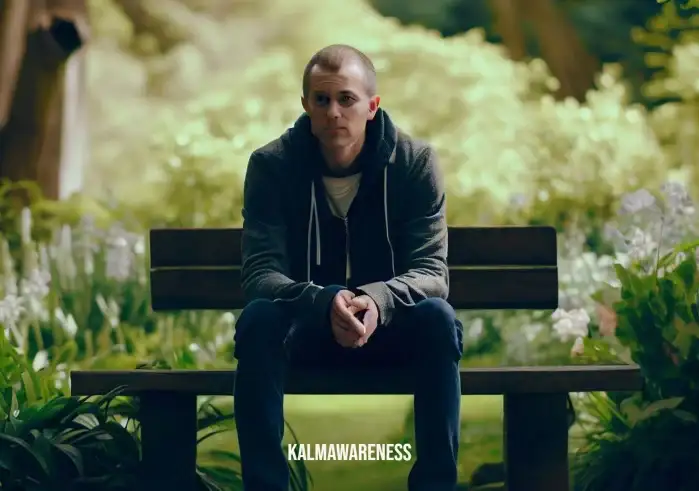The Art of Letting Go: How to Dissolve Desire and Embrace Contentment
From the bustling traffic on our morning commute to the never-ending demands at work, we are often met with circumstances that aren’t exactly to our liking. It’s easy to harbor desires for a better situation, for things to change according to our wishes. But what if we told you there’s another way? Learning how to let go of desire is an art that, when mastered, can lead to newfound freedom and deep, enduring contentment. Let’s embark on this transformative journey.
Letting Go: A Path Towards Personal Growth
The path towards personal growth often involves taking a deep, introspective look at our desires. These yearnings can take many forms, from the trivial to the life-altering. But, what happens when we start cutting chords to these desires?
Letting go of desire isn’t about repression or denial. Instead, it’s about understanding our desires, discerning their roots, and releasing the grasp they have on our thoughts and emotions. When we no longer look to external circumstances for happiness, we step into a place of profound inner peace and acceptance.
“As you dissolve into love, your ego fades. You’re not thinking about loving; you’re just being love, radiating like the sun.” – Ram Dass
Understanding Desire and Detachment
From a mindfulness perspective, desires are not inherently bad. They drive motivation, spark creativity, and inspire us to better ourselves. The issue arises when we become overly attached to these desires.
In this context, we find wisdom in the practice of cutting cords of attachment. This doesn’t mean we stop caring or feeling. Instead, we strive to love and live freely, without the weight of expectation or the need for reciprocation.
The Role of Meditation
So, how can we practice letting go of desire? This is where mindfulness meditation steps in as a powerful tool. During meditation, we simply observe our desires without judgment, understanding them as transient thoughts that come and go. Over time, this practice loosens the grip of desire, helping us to navigate life with a greater sense of equanimity.
Remember
- Meditation isn’t about “getting rid” of thoughts or desires.
- The goal is to develop a different relationship with your thoughts, one where you’re not controlled by them.
By embracing practices like thought-watching and affectionate breathing, we learn to observe our desires without becoming entangled in them. In this space of observation, we can then make a conscious choice to let go.
We invite you to continue to the next part of the article where we delve deeper into the tools and techniques for cultivating detachment, and how to apply the practice of letting go in your everyday life. Stay tuned for practical exercises and enlightening insights that will guide you on your path of letting go of desire.

The Practice of Letting Go: Tools and Techniques
With an understanding of the importance and the process of letting go of desire, it is time to delve into some practical exercises that can help us embody this liberating practice in our everyday lives. Whether it’s through meditation, daily reminders, or the intentional fostering of acceptance, we can integrate these practices to assist us in our journey of personal growth and self-discovery.
1. Cutting Energy Cords
An essential technique for letting go of desire is the practice of cutting energy cords. We all form energetic connections with people, places, and events in our lives, and sometimes these bonds, when unhealthy, can lead to excessive desire and attachment.
2. Forgiveness Meditation
Another powerful technique on how to let go of desire involves forgiveness, particularly forgiveness towards oneself. When we release past regrets and let go of self-blame, we naturally dissolve many desires that arise from a place of self-criticism.
3. Understanding and Accepting Imperfection
Perfection is a myth. Our desire for it is often the root of discontent. Embracing our imperfections, and those of others, is a critical step in our journey of letting go. Take solace in the understanding that we are perfect in the way that we are, even with our flaws and shortcomings.
4. The Power of Non-Attachment
Non-attachment, or the practice of desapego, is not about denying our feelings or becoming emotionally distant. Instead, it’s about loosening our grip on outcomes, desires, and even relationships.
- Practice “open-handed” living, allowing life to flow without resistance
- Be mindful of when you are gripping tightly to expectations
- Cultivate contentment in the present moment, regardless of external circumstances
One of the great Buddhist teachings is the concept of “equanimity” or mental calmness, composure, and evenness of temper, especially in difficult situations. This is a state that we can strive for as we continue on our journey of letting go. For this, we can turn to the practice of equanimity meditation.
Here’s a brief overview of these techniques for letting go:
| Technique | Practice | Internal Link |
|---|---|---|
| Cutting Energy Cords | Regularly perform cord-cutting meditations | Link |
| Forgiveness Meditation | Direct loving-kindness towards yourself in meditations | Link |
| Accepting Imperfection | Embrace the concept of “wabi-sabi### 4. The Power of Non-Attachment |
Non-attachment, or the practice of desapego, is not about denying our feelings or becoming emotionally distant. Instead, it’s about loosening our grip on outcomes, desires, and even relationships.
- Practice “open-handed” living, allowing life to flow without resistance
- Be mindful of when you are gripping tightly to expectations
- Cultivate contentment in the present moment, regardless of external circumstances
One of the great Buddhist teachings is the concept of “equanimity” or mental calmness, composure, and evenness of temper, especially in difficult situations. This is a state that we can strive for as we continue on our journey of letting go. For this, we can turn to the practice of equanimity meditation.
Here’s a brief overview of these techniques for letting go:
| Technique | Practice | Internal Link |
|---|---|---|
| Cutting Energy Cords | Regularly perform cord-cutting meditations | Link |
| Forgiveness Meditation | Direct loving-kindness towards yourself in meditations | Link |
| Accepting Imperfection | Embrace the concept of “wabi-sabi,” and extend acceptance towards others | Link |
| The Power of Non-Attachment | Practice “open-handed” living and be mindful of your expectations | Link |
| Equanimity Meditation | Cultivate mental calmness and evenness of temper | Link |
As we conclude this section, we invite you to continue exploring the transformative art of letting go of desire. In the next part of the article, we delve into understanding the impact of letting go on our relationships, self-perception, and overall quality of life. We’ll discuss how to use these practices in specific situations and the benefits that come from living a life free of excessive desire.

Reaping the Benefits: The Impact of Letting Go of Desire on Self and Relationships
Transitioning into a lifestyle where we learn how to let go of desire has profound implications on our personal development and relationships. While this journey can be challenging, the rewards are well worth the effort. This part of the article sheds light on how letting go of desire enriches our self-perception, transforms our relationships, and enhances our overall life experience.
A Shift in Self-Perception
As we let go of desire, our self-perception undergoes a radical shift. Instead of defining ourselves by our wants, needs, and expectations, we begin to appreciate ourselves for who we truly are. This shift gives birth to a more profound sense of self-acceptance and self-love. As Brené Brown defines it, true love emerges when we can extend to ourselves the same kindness we offer to others. In the wise words of Gautama Buddha,
“You yourself, as much as anybody in the entire universe, deserve your love and affection.”
By practicing affectionate breathing meditation, we can cultivate an atmosphere of self-love, facilitating the journey of letting go of desires.
Relationship Transformation
Our relationships, too, can transform when we learn to let go of desire. Instead of fostering attachments based on expectation, we can appreciate our loved ones for their true selves. We are then better equipped to cut cords to toxic relationships, freeing ourselves from the cycle of co-dependency.
The influential spiritual teacher, Ram Dass, eloquently stated,
“Love is not a matter of getting connected; it is a matter of seeing that we already are connected within an intricate web of relationships that extends throughout all life.”
Cultivating this vision can lead to healthier, more fulfilling relationships.
Enhanced Quality of Life
As we master the art of letting go, we discover a newfound sense of freedom and peace. Our happiness is no longer contingent on external circumstances. As a result, we experience a deepened sense of joy, tranquility, and equanimity. It is important to remember that it’s not about ridding ourselves of all desires but rather learning to find balance. As Jack Kornfield, a prominent teacher in the Vipassana movement in the West, explains,
“Let go of the battle. Breathe quietly and let it be. Let your body relax and your heart soften. Open to whatever you experience without fighting.”
By practicing letting go of control in meditation, we can learn to surrender, enhancing our overall quality of life.
From transforming our self-perception and relationships to improving our overall quality of life, letting go of desire indeed offers bountiful benefits. As we continue to explore this topic in the next section, we will discuss further its relevance in various aspects of our life, including emotional well-being, spiritual growth, and mindfulness. Keep reading to delve deeper into the transformative power of letting go.

Uncovering the Layers: Emotional and Spiritual Facets of Letting Go of Desire
Our journey of learning how to let go of desire invites us to uncover layers of our emotional and spiritual self. As we navigate through this inner landscape, we discover the power of forgiveness, equanimity, and mindfulness in our path to liberation from the chains of desire.
The Power of Forgiveness
Forgiveness is a cornerstone of the emotional healing process and an essential step towards learning to let go of desire. We often hold onto resentment and pain, which fuels our desires and expectations. However, as we learn to forgive ourselves and others, we release these emotional blockages, creating room for peace and acceptance. As Mark Twain once beautifully articulated,
“Forgiveness is the fragrance that the violet sheds on the heel that has crushed it.”
Embracing this wisdom, we can practice forgiveness using guided meditations such as this one to facilitate our journey towards letting go of desire.
The Practice of Equanimity
Equanimity, the state of psychological stability and composure unaffected by desire or aversion, is a profound spiritual practice. It involves observing our experiences without judgement or attachment, allowing us to maintain inner peace regardless of external circumstances. Sharon Salzberg, a renowned meditation teacher, defines equanimity as,
“A perfect, unshakable balance of mind.”
To nurture this state, one might follow the equanimity meditation script, which can guide us towards inner balance and freedom from desires.
Mindfulness: The Key to Liberation
Mindfulness, the practice of maintaining a moment-by-moment awareness of our thoughts, feelings, and surrounding environment, is key to liberation from desires. Thich Nhat Hanh, a world-renowned Zen master, elucidates,
“Mindfulness helps you go home to the present. And every time you go there and recognize a condition of happiness that you have, happiness comes.”
By practicing mindfulness, such as sitting with emotions and thought watching, we can let go of desire by being fully present and content with the ‘here and now’.
| Practices to Let Go of Desire | Benefits |
|---|---|
| Forgiveness | Release emotional blockages, promote peace and acceptance |
| Equanimity | Cultivate psychological stability and composure |
| Mindfulness | Encourage presence, contentment with the ‘here and now’ |
From the transformative power of forgiveness and equanimity to the liberation offered by mindfulness, the emotional and spiritual facets of letting go of desire reveal a path towards inner peace and contentment. In our final section of this article, we will explore practical strategies to let go of desire and how this powerful process can enrich our day-to-day life. Stay tuned to uncover more insights on this transformative journey.

The Road to Freedom: Practical Strategies to Let Go of Desire
As we embark on the last leg of our transformative journey, it becomes crucial to translate the theories we’ve learned into daily practice. By integrating practical strategies into our everyday lives, we can navigate the path of how to let go of desire with more ease and grace. This journey ultimately leads us to the heart of personal growth, acceptance, and a deeper connection with ourselves and the world around us.
Daily Rituals for Cutting Chords of Attachment
Daily rituals can play a significant role in helping us to let go of desire by cutting the energetic cords of attachment. Just as one cuts the umbilical cord to signify a newborn’s independence, we can also cut the energetic cords with our past, beliefs, expectations, and relationships that no longer serve us.
Furthermore, to release these attachments, we can engage in a cord-cutting meditation, creating space for new growth and transformation. This practice can help us live in the present moment, free from the constraints of past desires and anticipations.
Embracing Imperfections and Loving Ourselves
As Leonard Cohen lyrically put it:
“There is a crack in everything. That’s how the light gets in.”
When we recognize our imperfections and embrace them, we can learn to love ourselves just as we are. This self-acceptance acts as a powerful antidote to desire, as it replaces the longing for perfection with a loving appreciation of our unique flaws. For instance, consider the power of loving your imperfections. When we understand that being perfectly imperfect is the true nature of existence, we find peace in our own being, free of desires.
Breathing Exercises and Affectionate Breathing
Breathing exercises can be a practical tool in our quest to let go of desire. As we focus on our breath, we anchor ourselves in the present moment and let go of our desires, which are often rooted in the past or the future. Practices like affectionate breathing can guide us to a state of calmness and acceptance, serving as a balm for the longing soul.
Letting Go Through Mindful Acceptance
Finally, mindful acceptance is the key to unlocking the door to freedom from desire. As we cultivate the art of acceptance through meditation, we learn to embrace our experiences without striving for them to be different. As the Zen master Suzuki Roshi famously said:
“The best way to control cow and sheep is to give them a big grazing field.”
Through acceptance, we give ourselves the space to experience life fully and openly, free from the constraints of desire.
Implementing these practical strategies in our daily lives can illuminate the path to letting go of desire. As we align our actions with our intention to release desire, we find ourselves at the crossroads of personal growth, self-acceptance, and an enriched life. This concludes our exploration of how to let go of desire. Hopefully, these insights will inspire you to embark on your own journey of liberation from desire and towards inner peace.

The Art of Letting Go: Cultivating Joy in a World Free of Desire
As we conclude our journey through the intricacies of how to let go of desire, we hope you’ve found these insights enlightening. Throughout this odyssey, we’ve delved into the philosophical foundations of desire, explored psychological perspectives, and offered practical strategies to help navigate the road to personal growth and freedom. Now, we turn our gaze to the outcome of these efforts, the cultivation of joy, and a richer life in a world free of desire.
Seeking Equanimity through Meditation
Our quest to let go of desire leads us inevitably to the pursuit of equanimity. This state of calm and composure, undisturbed by desire or aversion, is a core component of mindfulness and can be nurtured through regular equanimity meditation. Embracing an equanimous mind helps us perceive events with a balanced outlook, devoid of desire, and saturated with serene acceptance.
The Joy of Letting Go
Interestingly, letting go of desire does not lead to a joyless life. On the contrary, it uncovers a deep wellspring of joy that exists independently of external circumstances. Letting go of things not meant for you can indeed be a liberating experience, one that brings a sense of freedom and tranquility. Detachment from desires allows us to live in the present, enjoying life’s simple pleasures unadorned by the craving for more.
Embodied Mindfulness: Living in the Present
Our journey toward a desire-less existence necessitates the practice of embodied mindfulness. This involves consciously anchoring ourselves in the present moment, acutely aware of our bodies, thoughts, emotions, and environment. Living in the now reduces the allure of desire, which often pulls us into the past or the future. This practice, thus, acts as an antidote to the pull of desire, leading us to a life of fulfillment and peace.
A Lifelong Journey
Remember, the journey to let go of desire is not a one-time event; it’s a lifelong journey. It takes continuous effort, patience, and compassion towards oneself. However, the reward of this journey—inner peace, contentment, and a life free of the shackles of desire—is truly worth the effort.
We hope this exploration of how to let go of desire has sparked curiosity and motivation in you to start or deepen your journey. As you step into a world that is less about wanting and more about being, we invite you to delve further into the world of personal growth, meditation, mindfulness, and more by exploring other articles on our Kalm Awareness site. Thank you for embarking on this journey with us. Here’s to your path towards liberation, acceptance, and profound joy!





